Lowell Year in Review: 2016
Some observations from the past year
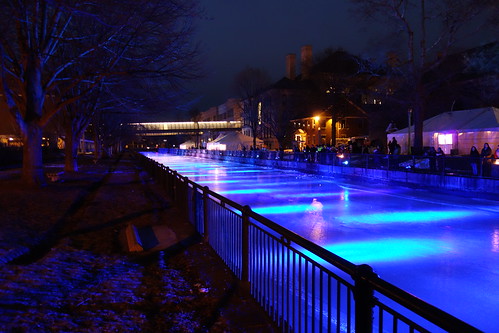
Merrimack Canal lit up during Winterfest
Waterways Vitality Project
Kicking off with a big meeting at Luna Theater on January 28, 2016 and led by Fred Faust and Paul Marion with great assistance from the city, UMass Lowell, the National Park, and other partners, the Waterways Vitality Project made huge strides this year towards extracting more communal value from our canals and rivers. Other public meetings on February 11, March 10, and October 27, helped propel the project onward, but the highlights were the two lighting demonstrations. The first happened in February during Winterfest when the Merrimack Canal adjacent to Lucy Larcom Park was illuminated in cool winter colors that reflected off the frozen surface of the canal. After a rainout of the Lower Locks lighting on April 7, the Swamp Locks illumination on September 1 was a huge success.
Beside these two canal lightings, a number of downtown buildings were illuminated and plans are already in place to increase the instances of nighttime illumination of notable structures as a means of promoting civic pride, drawing visitors from near and far, and assisting with overall economic development in the city.

Presidential Election
The 2016 Presidential Election seized Lowell’s attention early in January when Donald Trump held a rally at the UMass Lowell Tsongas Center. The large, enthusiastic crowd should have been a tip-off that Donald Trump would be a more formidable candidate than many of us realized at the time. A Washington Post article on the day of the rally did provide some insight, explaining that Trump’s support was strongest in areas with a lot of “registered Democrats who identify as Republicans” which I think accurately describes much of the Greater Lowell electorate.
In October, former Secretary of Labor Robert Reich came to Lowell for the inaugural CTI Community Conversation, and shared his view of the presidential race and the state of the country. Reich, who had supported Bernie Sanders, said that while on a book tour in some of the reddest parts of the country earlier this year, he constantly encountered people who were planning to vote for either Trump or Sanders, something that astounded Reich given the vastly different policy positions of the two. The attraction, however, was that both Sanders and Trump were perceived to be outsiders who would shake up the establishment. Reich advised his audience that the anti-establishment forces being unleashed in this election were not going away, and our country faced a choice between Authoritarian Populism and Reform Populism in the years to come.
Another connection between Donald Trump and Bernie Sanders was that Lowell-natives played central roles in both campaigns with Corey Lewandowski as Trump’s early campaign manager, and Michaeleen Earle Crowell as Sanders’ chief of staff.
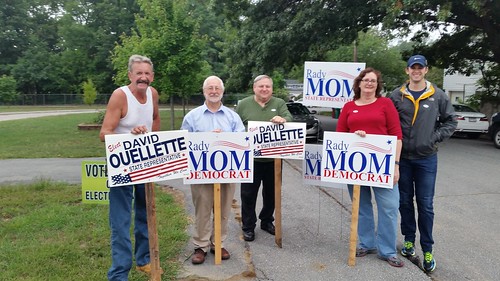
Closer to home, the state primary election was held on the Thursday after Labor Day. The notable race that day was for the 18th Middlesex Representative District where first-term incumbent Rady Mom defeated two Democratic opponents, gaining 1,074 votes to 615 for Dave Ouellette and 402 for Cheth Khim. With few other contested races on the ballot, only 4909 people voted.
With the office of President on the ballot, the general election was assured of a much bigger turnout. With “early voting” available for the first time in recent memory, 36,783 out of 64,683 voters (57%) cast ballots in the election. In Lowell, Hillary Clinton received 23,186 to Donald Trump’s 10,495. In the Third Congressional District, incumbent Niki Tsongas defeated Ann Wofford with Tsongas receiving 27,889 votes in Lowell to Wofford’s 6,805. Facing a Republican challenger, Rady Mom prevailed again in the 18th Middlesex District, receiving 7,985 votes to 3,091 for Kamara Kay.
There were also four questions on the ballot. In Lowell, Question 1 (additional slots casino), got 17,104 yes votes, to 15,540 no; Question 2 (more charter schools), 19,514 no votes to 14,847 yes; Question 3 (humane treatment of farm animals) 26,180 yes to 7,880 no; and Question 4 (legalize marijuana) 19,621 yes to 15,565 no. (Statewide, the No votes prevailed on Questions 1 and 2, and Yes prevailed on questions 3 and 4).
Civic Activism
While turnout in local elections remains depressingly low, the right issue can draw a lot of people to City Hall, even if it’s not central to the function of the city council. In January, supporters of the Second Amendment showed up to advocate an easier pathway to obtaining a license to carry a gun in Lowell.
In April, more than 400 members of the city’s Cambodian population came to a council meeting to protest a planned official visit by Cambodian General Hun Manet, the son of that country’s prime minister. Although a handful spoke in support of the visit, the overwhelming majority opposed it, and the council ended up rescinding the city’s invitation.
In May, hundreds more residents came to a council meeting to oppose a motion by Councilor Rodney Elliott that the city council send a resolution to the state legislature opposing a pending bill that would better accommodate the needs of transgendered individuals. After hearing from citizens for and against (but mostly for the legislative bill), the council instead voted for a substitute resolution that supported rather than opposed the bill.
In June, residents of the Perkins Place apartments, which had just been sold to UMass Lowell (more on that below) eloquently told the councilors how much they loved living along the Merrimack River in this refurbished mill building, and how distressed they were at having to move.
In November, supporters of the River Meadow Brook Trail reminded councilors of the importance to the community of walking trails when a portion of the proposed trail was about to be blocked by expansion plans of a neighboring business. In the end, the business got what it needed and the city has taken significant steps to develop a work-around for the trail.
In city council-related matters, councilors voted to increase the salaries of their successors beginning in January 2018 from the current $15,000 per year to $25,000 (with the mayor’s pay going to $30,000, and school committee members to $12,000). Also, the council voted to alter the method of gaining access to the ballot by increasing the nomination signature requirement from 50 to 150, and increasing the number of candidates needed to trigger a preliminary election from 19 to 25 (as for these last two, I do not recall whether the council enacted them outright, or if they need further action by the state legislature). Finally, a motion by Councilor Rodney Elliott that the council study a district councilor system died when it was not seconded.
Infrastructure
It’s easy to take for granted all that local government does for communal infrastructure, but how we move from place to place is vitally important to any community, especially a city like Lowell. There were some wins and some losses for infrastructure in 2016. Back in March, City Manager Murphy and city planners delighted several hundred community members gathered at the senior center by unveiling an innovative proposal to “fill in” the Lord Overpass and turn it into a complex, grade-level intersection. The proposal was controversial, however, and indications are that planners have reverted back to a more traditional plan which will be unveiled to city councilors this month (January 2017).
The city seems to have finally solved the “where to park buses visiting Lowell National Park” which has held up a new city parking garage for the Hamilton Canal District. Space owned by the MBTA and controlled by the LRTA that lay between YMCA Drive and the Lowell Connector was identified and secured by the city. Detailed design planning for the 900 space garage is now underway.
In February, the city received a $15mil Federal TIGER grant to help purchase a number of inner city bridges that carry important roads over various canals. These bridges have been owned by Enel which has been less than diligent in its upkeep and repairs. By gaining ownership, the city will better control key canal-crossings.
Also in February, long-standing plans for a major extension of the Lowell trolley system died a quiet death. While the cost of construction was an issue, the death blow came from the future costs of operation which none of the entities involved was ready to take on.
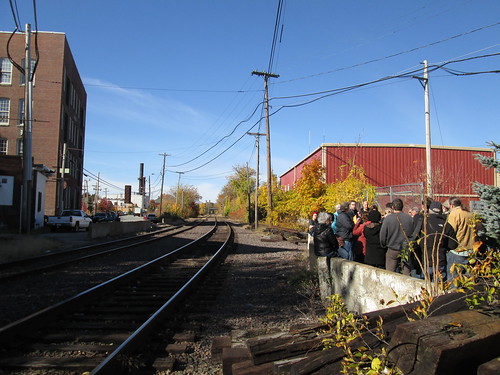
Railroad tracks blocking path from Dutton St (right) to Western Ave (left)
Despite a number of tries by various people and entities, gaining access to Western Avenue Studios from Dutton Street remains an unmet challenge. At a December meeting at Western Ave, city planners made it clear that the dead end on that road will stay a dead end, because crossing the railroad tracks, either using an at-grade crossing or a pedestrian bridge over the tracks, is just not feasible. A glimmer of hope did emerge from the meeting with news that Lowell National Park is contemplating a future Pawtucket Canal Walkway which would pass Western Ave Studios on the other side of the Pawtucket Canal (and which would safely pass underneath the railroad tracks) and that an additional pedestrian bridge across the Canal to this Walkway would be feasible and relatively affordable. Make no mistake: an NPS Pawtucket Canal Walkway is still very far in the future, but perhaps the city and other entities might help speed the process at the Thorndike Street end of this proposed walkway as a way of solving the Western Avenue access riddle.
Proposals to widen two already-busy roads met with some criticism in 2016. The first would widen Nesmith Street as it approaches East Merrimack, which would require the removal of a number of very mature trees that now line the road along Kittredge Park. The other project, somewhat less controversial, would widen Thorndike Street along the South Common to facilitate access to and from the Thorndike Exchange residential-retail-restaurant complex now under construction. The Thorndike Exchange project also comes with a state-funded pedestrian walkway from the main building (the former Hood Patent Medicine Factory) directly into the second floor of the Gallagher Terminal.
Speaking of the Gallagher Terminal, at a council transportation subcommittee meeting in mid-December, some exciting multi-modal proposals were discussed including the recent arrival of Zip Cars at Gallagher and plans to allow UMass Lowell students to ride LRTA buses simply by showing their school ID cards.
In matters related to downtown infrastructure, repair work continues at the Market Street and Lower Locks parking garages, while demand for parking spaces soars. And the council passed an ordinance banning food trucks from much of the central downtown business district as a way to (1) protect existing restaurants and (2) to preserve highly valued curbside parking spaces.
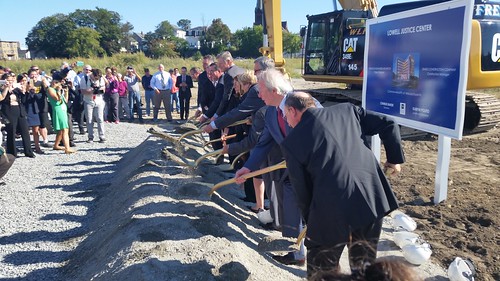
Groundbreaking for Lowell Justice Center
Public Buildings
Perhaps equal to infrastructure in importance in promoting a community are public buildings. A big boost occurred on September 22 when Governor Charlie Baker and other notables came to Lowell for the long-awaited ground breaking for the Lowell Justice Center on Jackson Street in the Hamilton Canal District. Construction of this seven-story, glass and steel courthouse is well underway with completion expected in 2019.
Plans for new public buildings were also in the news in 2016. Foremost of these is a new Lowell High School, or a partially new, partially renovated Lowell High School, or an entirely renovated Lowell High School. Taking advantage of 80% state reimbursement for the cost of construction, the city has moved aggressively through the process. By the end of 2016, however, city leaders face tough questions on the extent to which LHS will be replaced or repaired, where the school should be located, and how much will residents be willing to pay for it. All of those questions should be answered in 2017.
Also during 2016, the city received proposals for a new police station (estimated cost of $55mil) and a new DPW facility (estimated cost $35mil).
During 2016, the city also accepted a proposal from the Coalition for a Better Acre to take ownership of the city-owned Smith Baker Center and convert it into a community center and performance space. Although no work has been performed on the building, CBA is diligently seeking funding for the project.
Although not a publicly-owned asset, the Lowell Spinners play at publically-owned Lelacheur Park. Longtime owner Drew Weber sold the team this year and the city continues lease renewal negotiations with the team’s new owner, Dave Heller.
The city selected Winn Development to be the new Master Developer of the Hamilton Canal District. Winn replaced Trinity, which withdrew from the project after holding that position since the project’s inception. Winn’s short tenure has not been free of controversy as city councilors have struggled with how much, if any, residential units should be constructed in the District.
Not all public building news was greeted with great fanfare. When news broke in the spring that UMass Lowell would purchase the Perkins Place apartments and convert them to residences for university students and staff, several city councilors were extremely critical of the university, both for deleting from the property tax rolls such a large structure, but also for displacing tenants who seemed to fit the prototype the city was most anxious to attract. As a consequence of this controversy, City Manager Kevin Murphy and UMass Lowell Chancellor Jacquie Moloney entered into negotiations to more clearly define the fiscal relationship between the city and the university. Despite some rocky moments in that process, a final agreement was reached to the apparent satisfaction of both parties. Still, the controversy undoubtedly left some scars and the long term consequences of that remain to be seen.
Private Development
As mentioned above, Sal Lupoli’s Thorndike Exchange transformation of the old Hood Medicine Plant (more recently, the Thorndike Factory Outlet), races ahead with a mixed use blend of commercial space, restaurants and residences adjacent to the Gallagher Transportation Terminal. The rapid pace of Lupoli’s progress is challenged by Vision Development’s five story, 156 unit, privately owned college dormitory that’s quickly arising on Fr. Morrissette Boulevard on the former site of the Lowell Five Cent Savings Bank headquarters (which moved to Tewksbury this year). Although not affiliated with either UMass Lowell or Middlesex Community College, the Vision building will be marketed primarily to students attending both of those schools.
Great news came in March when Kronos announced it was moving its company headquarters from Chelmsford to Lowell where it will occupy a full tower of the Cross Point complex. Because they lack controversy, stories like this tend to quietly disappear from local news, but Kronos coming to Lowell is huge and should be repeatedly celebrated.
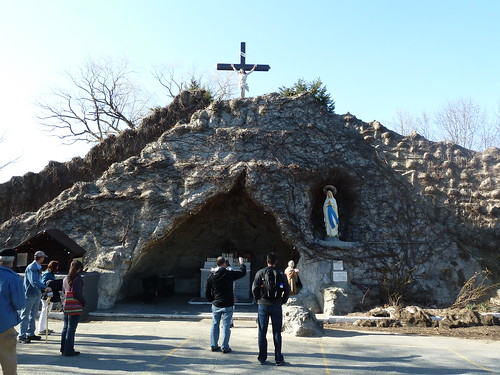
The Grotto behind Franco American School
In December, the trustees of the recently closed Franco American School announced an agreement to sell the school to a partnership of the Coalition for a Better Acre and TMI Development that will convert the property to residences while preserving the iconic Grotto and Stations of the Cross at the rear of the site.
Books
It was a good year for books and for people who love books. Hypertext Bookstore Café opened in February in the Cherry and Webb building and the Cultural Organization of Lowell opened the COOL Place retail outlet on Merrimack Street in the fall.
In March, the Pollard Memorial Library sponsored a “local author roundup” at Mill No. 5 as part of that month’s Pulp and Press Fair. In July, Paul Marion’s Loom Press held a “Loom Press writers reading” event at Hypertext. In the fall, the Pollard Memorial Library organized a memorable series of community events around the book Happy City by Charles Montgomery, which was the Lowell Reads book for 2016.
Also this year, Dave McKean’s Lowell Irish book made its debut, as did Mehmed Ali’s Yousuf Karch and John Garo.
It was also a big year for Jack Kerouac. The UMass Lowell Center for Lowell History opened a Kerouac Room in October, and the Library of America put out a new book of previously unpublished Kerouac writings, the fourth Kerouac hardcover in that most prestigious publishing line. Kerouac also soared by proxy when Bob Dylan received the Nobel Prize in Literature, as many Dylan-related articles explored the influence of Kerouac on Dylan.
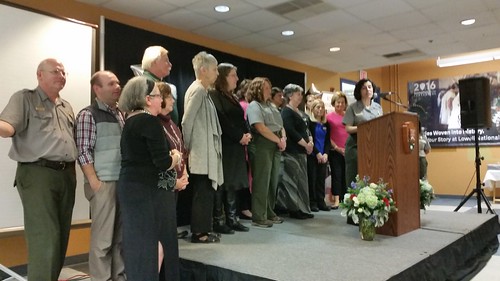
Lowell National Park Supt Celeste Bernardo and staff of Tsongas Industrial History Center
History
It was also a good year for history in Lowell. In August, Lowell National Historical Park celebrated the centennial of the National Park Service with a number of events. In October, the Tsongas Industrial History Center celebrated its 25th anniversary. On January 16, the Brush Gallery hosted Fred Faust, Paul Marion, Rosemary Noon, and Susan Gaylord, all key players in the creation of the Brush and the Market Mills Complex, for a behind the scenes retrospective on how that came about.
In September, UMass Lowell partnered again with Queen’s University Belfast to host an Irish History Conference that focused on the Battle of the Somme and the Easter Rising, two momentous events from one hundred years ago that had a huge impact on Ireland and substantial influence in Lowell. In May, the Lawrence History Center held a symposium on Urban Renewal that feature several speakers from and about Lowell.

Lowell Walks brought 100 people into downtown on summertime Saturday mornings
Lowell Walks sponsored 26 events that drew 1846 people during 2016. DIY Lowell erected signs for a downtown history trail, and the Lowell Historic Board affixed historic plaques to dozens of downtown buildings. The Moses Greeley Parker Lectures featured three talks that touched on Lowell, the production of cotton, and the American Civil War, an aspect of the city’s history which, along with the local Abolitionist movement, deserves more of our attention in the future. The three talks were Sven Beckert about his award-winning book, Empire of Cotton, Kevin Gallagher about his book Loom, and me about Solon Perkins and the recently-discovered Civil War flag that commemorates his death in combat.

Opioid Crisis
Unfortunately, no review of 2016 would be complete without mention of the opioid crisis and the devastation it has brought to our community. Overdose death rates continue to rise despite great effort by the city, nongovernmental agencies, and individuals, to combat the scourge of addiction.
Great, thx!!
Thank you for all you do to keep Lowellians informed about what is happening in their city.